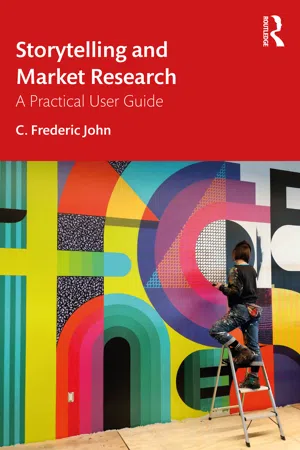
- 186 pages
- English
- ePUB (mobile friendly)
- Available on iOS & Android
About This Book
Showing how market researchers can get a seat at the decision-making table, this book is the essential guide to mastering storytelling techniques that can dramatically enhance the impact of research reports and presentations, commanding full audience engagement and buy-in.
While demand for storytelling in marketing research reports and presentations has mushroomed in recent years, there can be confusion about what decision-makers mean by "stories." Leading market research expert C. Frederic John eliminates this confusion by defining four specific types of story in the business arena, and providing a series of "how-to" guides for generating effective solutions when communicating learning and other information. This book is the first to emphasize the needs of the report reader or presentation audience.
Drawing on examples from ancient and modern literature, drama, opera, and other arts, this book will help today's (and tomorrow's) market research professionals to thrive in a world demanding insights, real-world recommendations, and more relevant deliverables.
Frequently asked questions
Chapter 1
The Fundamental Power of Story
- Its pervasiveness in our lives and in all forms of art
- The transformative properties that give stories such power
- The special roles and responsibilities of the storyteller
- How these roles and responsibilities apply to the market researcher
The Ubiquity of Story
The Compulsion to Explain
Stories Everywhere
- Those that accurately relate events that really happened, such as history, biography, and journalism, that we call non-fiction.
- Those that make no such claim, what we call fiction.
- “Betty has seven eggs, and she plans to sell them for 12 cents apiece…”
- “Two trains 100 miles apart start heading toward each other on parallel tracks. One is going 40 miles per hour, the second 60 miles per hour…”
Story = Sharing
- We can still respond in horror at the deceit of Agamemnon tricking his wife into sending their daughter to her death.3
- We can laugh at the foibles portrayed in Roman comedies, and in Shakespeare’s, as much as in Neil Simon’s.
- We are entertained as we move through the Arabian nights, and share the joys and agonies that fill novels from Cervantes to the present day…
- … Even though the societies shaping the stories, such as Edith Wharton’s New York, and even the situations themselves, no longer exist.
Many Arts Tell Stories
Stories Set in Music
- Even purely instrumental music can suggest a story in the form of program music, such as Vivaldi’s Four Seasons, Berlioz’ Symphonie Fantastique, and Smetana’s Moldeau.
- In these orchestral works, the composer provides a rough outline of a sequence of events and leaves the listener to imagine the scenes the music evokes.
Paintings: Stories Frozen in Time
- Many later paintings can be experienced as frozen images of a moment in time for which there is clearly a before and an after.
- Much the same can be said of many sculptures.
- This self-possessed young man, what is he really like? How does he live and act? What does his expression, his clothes, and his few possessions shown tell us?
- Our minds are tempted to imagine the answers and fill in the unstated gaps.
- (If you don’t have a traditional portrait in mind or on hand, you might check this one out: Circle of Raphael (Raffaello Sanzio) (1483–1520), Portrait of a Young Man in Red, c 1505.) Here is the link: https://commons.wikimedia.org/wiki/File:Circle_of_Raphael_(Raffaello_Sanzio)_-_Portrait_of_a_Young_Man_in_Red_-_78.PB.364_-_J._Paul_Getty_Museum.jpg
- That beautiful landscape—perhaps we can see ourselves walking across the fields, or it reminds us of past experiences when we basked in the bright sunshine in just such a meadow.
- (Again, if you need inspiration, here’s one that might work for you: John Constable, Wivenhoe Park, Essex, 1816.) You can view it here: https://artsandculture.google.com/asset/wivenhoe-park-ssex/vAG0ovJU1U65Rw?hl=en
Other Art Forms
- Try to remember some of the earliest stories that were read or told to you as a child.
- What aspects can you still recall?
- What about these particular tales give them their “sticking” power so many years later?
- Can you remember anything about what you felt as you heard these stories?
- Remember explaining something to someone, and using an example to get a point across; for example, how a process works, what a law means, or a scientific principle.
- Why do you think you went from the general (what you were explaining) to the specific (an example)?
- How did you come up with the example you used?
- Did citing an example make it easier for the person to understand what you were explaining?
The Transformative Properties of Story
Table of contents
- Cover
- Half Title
- Title Page
- Copyright Page
- Contents
- Preface and Acknowledgments
- Introduction
- 1 The Fundamental Power of Story
- 2 The Immediate and the Essential
- 3 Tales Clients Tell
- 4 The Written Report as Narrative
- 5 A Radically New Approach to the Presentation
- 6 Humanizing the Presentation
- 7 Recasting the Narrative as an Imaginary Tale
- 8 The Story of a Company or Brand
- 9 Continuous Learning
- Appendix: “Landscape and Narrative”
- Index